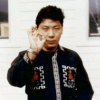Chogyam Trungpa

Chogyam Trungpa
Chögyam Trungpawas a Buddhist meditation master and holder of both the Kagyu and Nyingma lineages, the eleventh Trungpa tülku, a tertön, supreme abbot of the Surmang monasteries, scholar, teacher, poet, artist, and originator of a radical re-presentation of Shambhala vision...
NationalityTibetan
ProfessionPhilosopher
passion views practice
The practice of meditation is a way of continuing one's confusion, chaos, aggression, and passion—but working with it, seeing it from the enlightened point of view.
fear practice people
We have a fear of facing ourselves. That is the obstacle. Experiencing the innermost core of our existence is very embarrassing to a lot of people. A lot of people turn to something that they hope will liberate them without their having to face themselves. That is impossible. We can't do that. We have to be honest with ourselves. We have to see our gut, our excrement, our most undesirable parts. We have to see them. That is the foundation of warriorship, basically speaking. Whatever is there, we have to face it, we have to look at it, study it, work with it and practice meditation with it.
journey practice profound
If there is some profound method that offers a quick way, we would rather follow that than undertake arduous journeys and difficult practices. But some manual work and physical effort is necessary.
meditation-practice world way
Meditation practice is regarded as a good and in fact excellent way to overcome warfare in the world; our own warfare as well as greater warfare.
distance journey practice
Our life is an endless journey; it is like a broad highway that extends infinitely into the distance. The practice of meditation provides a vehicle to travel on that road. Our journey consists of constant ups and downs ...
mean practice confusion
By means of meditation, I feel that we have planted dynamite to transcend the world of confusion. So it would be good if you could practice meditation as much as you can, as much as physically and psychologically possible. You could become more clear and sane, and you could also influence the national neurosis in that way.
meditation-practice mind sitting
In the practice of sitting meditation you relate to your daily life all the time. Meditation practice brings our neuroses to the surface rather than hiding them at the bottom of our minds. It enables us to relate to our lives as something workable.
acceptance experiencing-everything practice
The everyday practice is simply to develop a complete acceptance and openness to all situations and emotions and to all people, experiencing everything totally without mental reservations and blockages, so that one never withdraws or centralizes into oneself.
practice simplicity path
We must begin our practice by walking the narrow path of simplicity, the hinayana path, before we can walk upon the open highway of compassionate action, the mahayana path.
spiritual mean practice
The main point of any spiritual practice is to step out of the bureaucracy of ego. This means stepping out of ego's constant desire for a higher, more spiritual, more transcendental version of knowledge, religion, virtue, judgment, comfort, or whatever it is that the particular ego is seeking. One must step out of spiritual materialism.
practice emphasis situation
The emphasis on practice is because it is the only time in your life you can steer your karmic situation.
simple practice personality
In fact, a person always finds when he begins to practice meditation that all sorts of problems are brought out. Any hidden aspects of your personality are brought out into the open, for the simple reason that for the first time you are allowing yourself to see your state of mind as it is.
attitude practice meditation
Meditation practice is a way of making friends with ourselves. Whether we are worthy or unworthy, that's not the point. It's developing a friendly attitude to ourselves, accepting the hidden neurosis coming through.
begin beginnings birth climax courage cultivate cutting distant feels finally follows full hope ideas life messages natural nurture reached rhythms seems spring weave
There are times to cultivate and create, when you nurture your world and give birth to new ideas and ventures. There are times of flourishing and abundance, when life feels in full bloom, energized and expanding. And there are times of fruition, when things come to an end. They have reached their climax and must be harvested before they begin to fade. And finally of course, there are times that are cold, and cutting and empty, times when the spring of new beginnings seems like a distant dream. Those rhythms in life are natural events. They weave into one another as day follows night, bringing, not messages of hope and fear, but messages of how things are.